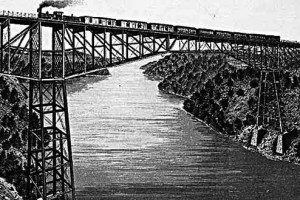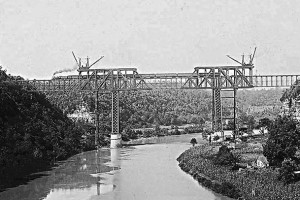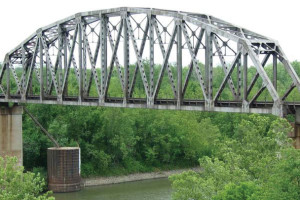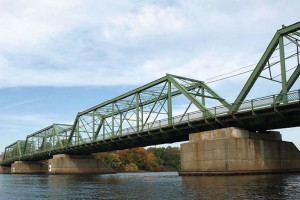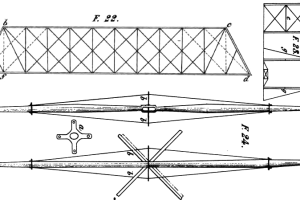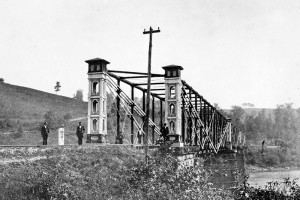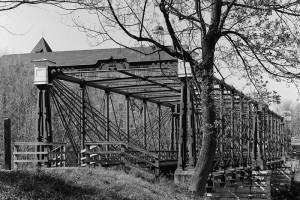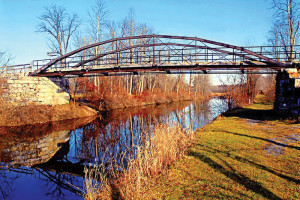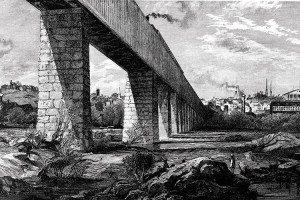The Niagara River gorge had long separated the United States from Canada. It varied in depth up to 239 feet and in width generally between 800 and 1,000 feet between the Falls and Lewiston. Around 1836, suspension bridges were proposed by Francis Hall at Lewiston-Queenston and just above the falls. Charles B. Stuart, in 1845, then working on the location of the Great Western Railway in Canada, was looking for a way to connect his line with the Rochester and Niagara Falls branch of the New York Central. …
Author Archives : Frank Griggs, Jr., Dist. M. ASCE, D. Eng., P.E., P.L.S.
About the author ⁄ Frank Griggs, Jr., Dist. M. ASCE, D. Eng., P.E., P.L.S.
Dr. Frank Griggs, Jr. specializes in the restoration of historic bridges, having restored many 19th Century cast and wrought iron bridges. He is now an Independent Consulting Engineer. (fgriggsjr@twc.com)
First Major Iron Cantilever Bridge in the United States
When engineers think of cantilever bridges, the Quebec Bridge with its 1,800-foot span and the Firth of Forth Bridge with its 1,710-foot spans come to mind. The cantilever principle in metal originated in Europe and the United States, but examples of cantilevers in wood and stone were found in many countries in the Far East, such as India, Tibet, China and Japan, as well as Norway and South America. …
Bridge historians and early textbooks generally call a truss with alternating compression and tension diagonals a Warren; however, sometimes it is called an equilateral truss since all panel lengths and diagonals are of equal length creating a series of equilateral triangles. When the panel lengths are shorter than the equal length diagonals, it was sometimes called an isosceles or isometric truss. …
Whipple, Single Canceled, Trapezoidal Truss
Most bridge historians and bridge textbooks state that a bridge with a single tension diagonal in each panel and a compression vertical with parallel chords and an inclined end post is a Pratt Truss. The usual truss profile is shown in Figure 1. …
Squire Whipple (STRUCTURE, September 2005 and November 2014) patented his bowstring truss in 1841 and built them across the Erie and other Canals and rivers. These were generally for wagons and carriages. In 1846/47, he wrote his A work on Bridge Building Consisting of two essays, The One Elementary and General, the other showing Original Plans and Practical Details for Iron and Wooden Bridges. In it he gave the first correct method of determining the load in every member of his truss by the method of joints, and even utilized a graphical method of determining these loads. …
After the success of Wendell Bollman’s truss at Harpers Ferry and elsewhere, Benjamin Latrobe encouraged Albert Fink to design a longer span iron bridge that he could use on his major river crossings between Harpers Ferry and the Ohio River. Fink (STRUCTURE, May 2006), after obtaining his engineering degree in Germany, immigrated to the United States in late spring 1849. He went to work on the B&O Railroad working with Wendel Bollman (STRUCTURE, February 2006) and Latrobe. …
The Bollman Truss was the first widely adopted cast and wrought iron railroad bridge in the United States. It was designed and patented by Wendel Bollman (STRUCTURE, February 2006) on January 6, 1852 after he built several on the B&O Railroad. Richard Osborne built an earlier iron bridge in 1845 on the Reading Railroad at Manayunk, a portion of which is now on display at the Smithsonian Institution in Washington. It consisted of three cast iron trusses with wrought iron verticals. …
Iron bridges in Great Britain date from 1779 when the cast iron Coalbrookdale Bridge was built across the Severn River. It was followed in 1796 with a bridge by Thomas Telford at Buildwas just upstream from Coalbrookdale. Telford also built several aqueducts of cast iron, as well as two other roadway bridges at Craigellachie in 1814 and Betws-y-Coed in 1815. He even proposed a cast iron bridge with a 600-foot span in 1799 to replace the London Bridge across the Thames River. …
First Railroad Bridge across the Connecticut River in Massachusetts
The Boston and Worcester Railroad, one of the first railroads built in Massachusetts, was chartered in 1831 and opened to Worcester in 1835. This was followed by the Western Railroad, which would begin in Worcester and run to the New York State line, connecting with the Hudson and Berkshire line that ran to Albany, New York, on the Hudson River. …
Mighty Colossus, Bestriding the Ancient Powhatan
It was early in railroad development in this country when the Richmond & Petersburg Railroad was proposed and chartered in 1836. It ran from just north of Petersburg on the north side of the Appomattox River to just south of Richmond on the James River. The charter stated the line could be extended into both Richmond and Petersburg upon the approval of the Common Council of each city. …

